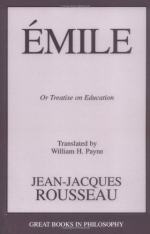Moreover, he knows by experience that there is always a reason for my slightest questions, though he may not see it at once; so he has not got into the habit of giving silly answers; on the contrary, he is on his guard, he considers things carefully and attentively before answering. He never gives me an answer unless he is satisfied with it himself, and he is hard to please. Lastly we neither of us take any pride in merely knowing a thing, but only in avoiding mistakes. We should be more ashamed to deceive ourselves with bad reasoning, than to find no explanation at all. There is no phrase so appropriate to us, or so often on our lips, as, “I do not know;” neither of us are ashamed to use it. But whether he gives the silly answer or whether he avoids it by our convenient phrase “I do not know,” my answer is the same. “Let us examine it.”
This stick immersed half way in the water is fixed in an upright position. To know if it is broken, how many things must be done before we take it out of the water or even touch it.
1. First we walk round it, and we see that the broken part follows us. So it is only our eye that changes it; looks do not make things move.
2. We look straight down on that end of the stick which is above the water, the stick is no longer bent, [Footnote: I have since found by more exact experiment that this is not the case. Refraction acts in a circle, and the stick appears larger at the end which is in the water, but this makes no difference to the strength of the argument, and the conclusion is correct.] the end near our eye exactly hides the other end. Has our eye set the stick straight?
3. We stir the surface of the water; we see the stick break into several pieces, it moves in zigzags and follows the ripples of the water. Can the motion we gave the water suffice to break, soften, or melt the stick like this?
4. We draw the water off, and little by little we see the stick straightening itself as the water sinks. Is not this more than enough to clear up the business and to discover refraction? So it is not true that our eyes deceive us, for nothing more has been required to correct the mistakes attributed to it.
Suppose the child were stupid enough not to perceive the result of these experiments, then you must call touch to the help of sight. Instead of taking the stick out of the water, leave it where it is and let the child pass his hand along it from end to end; he will feel no angle, therefore the stick is not broken.
You will tell me this is not mere judgment but formal reasoning. Just so; but do not you see that as soon as the mind has got any ideas at all, every judgment is a process of reasoning? So that as soon as we compare one sensation with another, we are beginning to reason. The art of judging and the art of reasoning are one and the same.
Emile will never learn dioptrics unless he learns with this stick. He will not have dissected insects nor counted the spots on the sun; he will not know what you mean by a microscope or a telescope. Your learned pupils will laugh at his ignorance and rightly, I intend him to invent these instruments before he uses them, and you will expect that to take some time.




